Vitiligo
1. What is Vitiligo?
Vitiligo is a disease presenting as white patches with or without white hairs in the involved area.
2. What is Leucoderma?
Leucoderma means only white patches on skin & can be due to a variety of causes apart from Vitiligo like chemicals, burns etc.
3. How Vitiligo occurs?
Normal color of skin is due to presence of pigment called 'Melanin' produced by cells known as melanocytes. In vitiligo, there is destruction of melanocytes leading to decreased melanin & thus white patches. It is a common condition, roughly affecting 3-4% of population in India.
4. What are the causes of Vitiligo?
The exact cause of destruction of melanocytes is not known. However following factors are supposed to play a role
1. Genetic - about 20-30% cases, someone in the family has the disease
2. Neural- disturbance in normal functioning of nerves which supply to skin may cause vitiligo
3. Autoimmune-body destroys its own melanocytes mistaking them as foreign substances
4. Self destruction of melanocytes due to absence of normal protective mechanisms
5. Increase in the levels of toxic metabolites in the body(free radicals)
5. What are the types of Vitiligo?
It is mainly of two types
Localized type, also known as 'segmental vitiligo'where patches are seen in a single/adjacent segment of body
'Vitiligo vulgaris' - in which patches are either wide-spread or may involve distal asymmetrical areas. It may be of different types like
I. Universal type- almost entire body is involved
II. Lip-tip type- involves face mainly lips & tips of fingers
III Focal type-with 1/2 lesions in single area
6. What are the triggering factors for Vitiligo?
• Physical/ emotional stress
• Rubber goods
• Chemicals
7. How Vitiligo is treated?
It mainly consists of
• General understanding of nature of disease
• Avoidance of triggering factors
• Need for good general health & nutritious diet
I. Medical therapy
a) Topical treatment(creams/lotions)
• Calineurin inhibitors-tacrolimus/pimecrolimus
• Corticosteroids-mild- moderate potency
• Corticosteroids-mild- moderate potency
• Basic fibroblast growth factor preparations
• Placental extract preparations
• Psoralen compounds
• Vitamin D derivatives - like calcipotriol
Oral treatment
Supplementation of vitamins & minerals
Oral steroids in very small doses & for short periods
Levamisole
Rarely- azathioprine/ cyclophosphamide
II Phototherapy - consisting of narrow band ultraviolet rays either alone or in combination of oral psoralens.
III Surgical management - Done in case of medically unresponsive cases, where disease is non-progressive. Different types of surgical modalities are available which include,
Skin grafting e.g. punch grafting
Melanocyte culture
Suction blister
